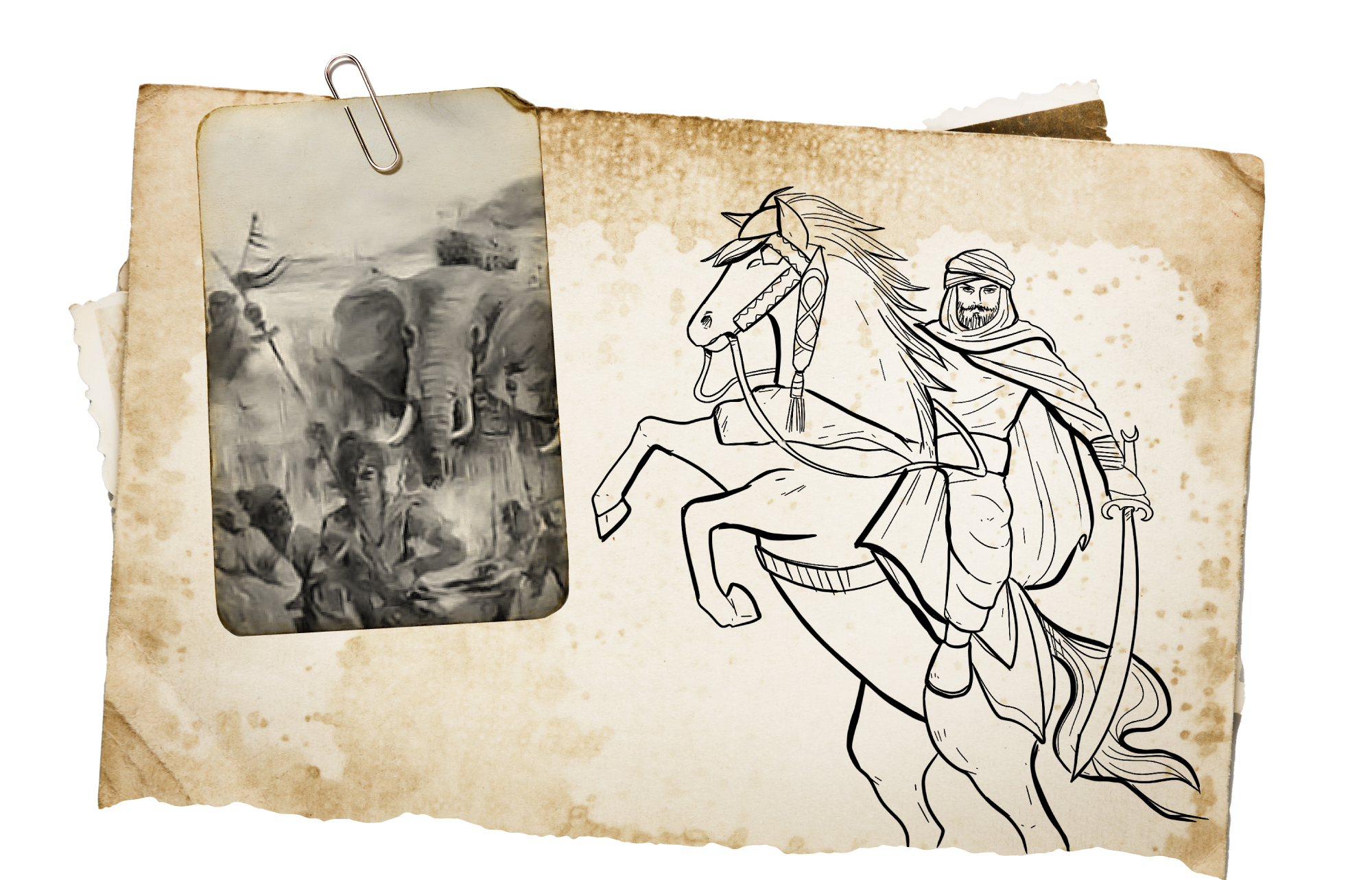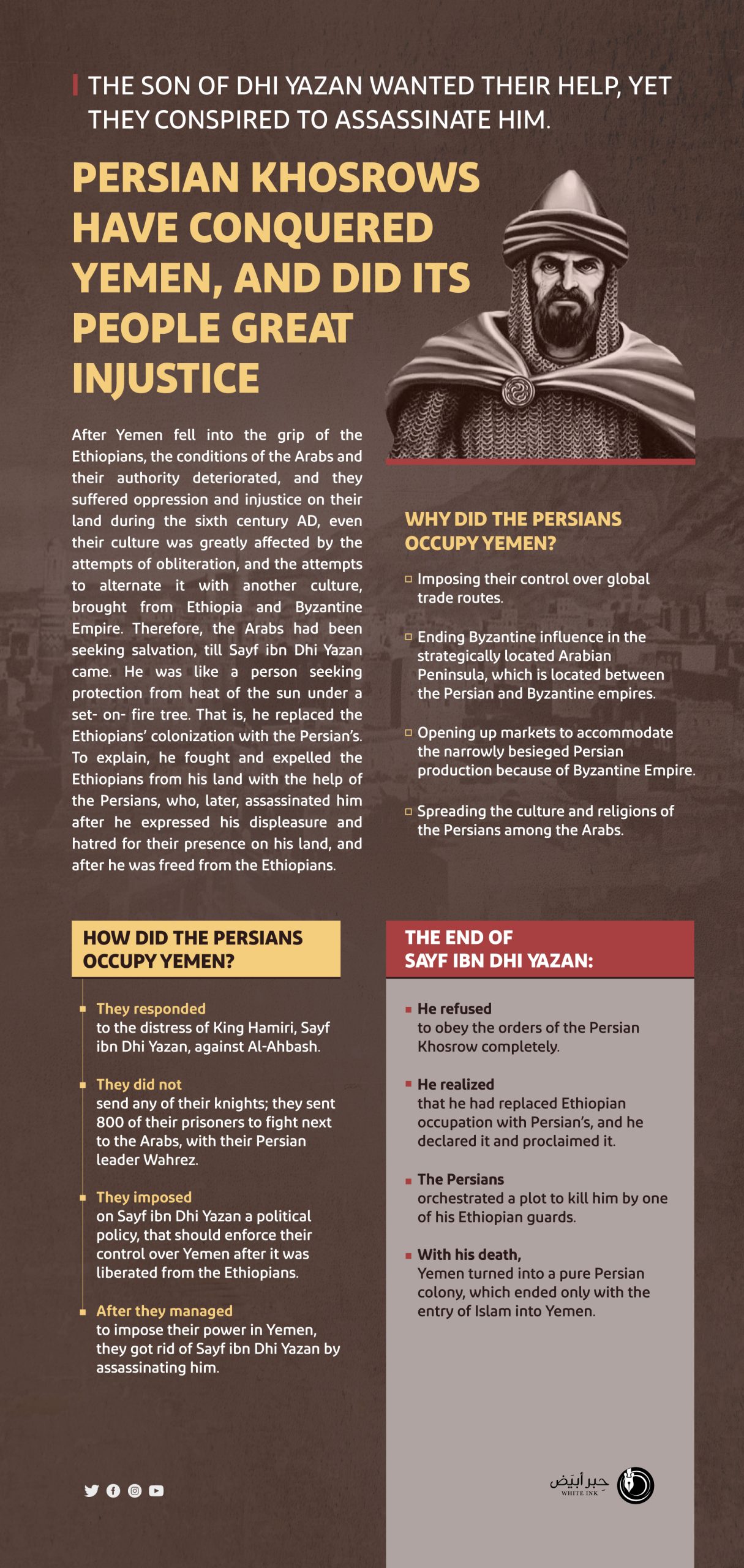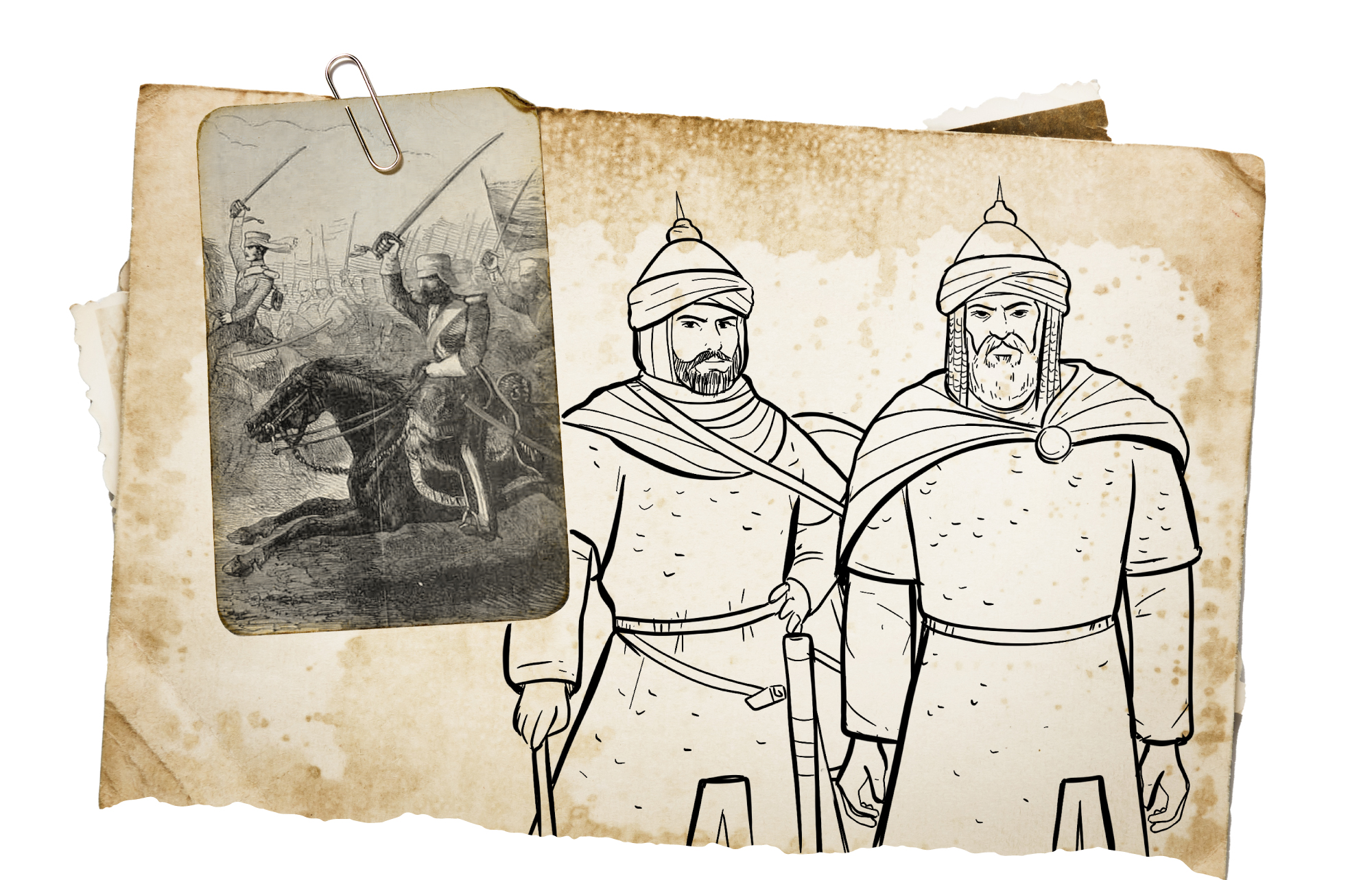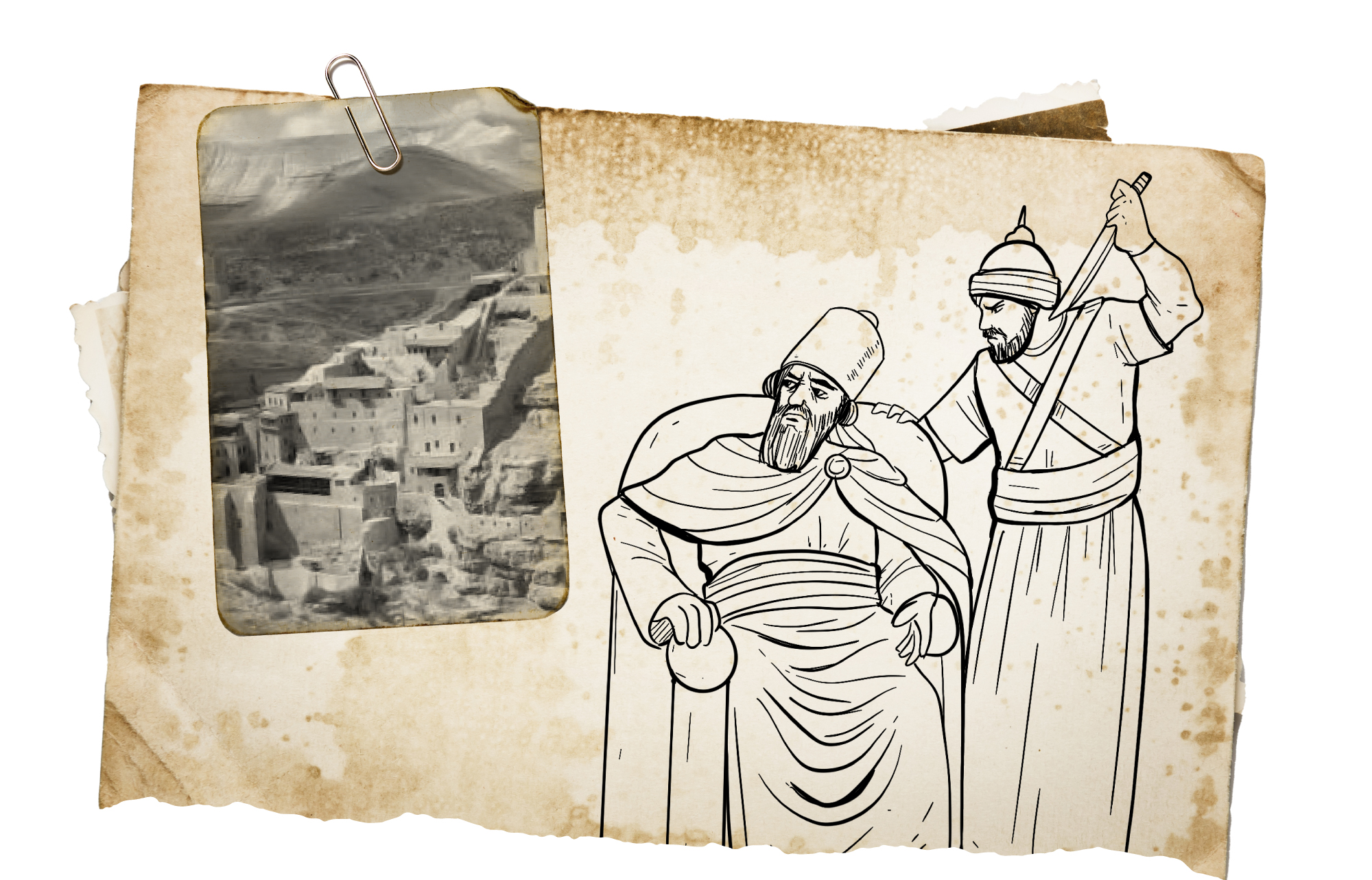
The Arab King who made the Biggest Mistake in History
King Sayf ibn Dhi Yazan who expelled the Abyssinians and brought Persians to Yemen
Historical views about the personality of the Arab King Sayf ibn Dhi Yazan (born: 516 – died: 574 CE) varied, upon whom tales and legends that exaggerated his description and powers were created. In general, he sought liberty from Abyssinians in Yemen during the second half of the 6th century. During that period, Yemen was languishing under the rule of Abyssinians, who tried to invade Mecca led by Abraha al-Habashi before the advent of Islam.
Some historical stories, including Ibn Kathir’s (Al-Bidaya wa’l-Nihaya) book, say that Abd al-Muttalib Prophet Mohammad’s (PBUH) grandfather lived in the era of Sayf ibn Dhi Yazan and visited him in his palace in Sana’a. The visit occurred when Abd al-Muttalib, one of Quraysh’s leaders, was on a trade journey to Yemen and the Levant.
Many historians depict Sayf ibn Dhi Yazan as the liberator of the land of Yemen from the Abyssinians, as he used the Persians to help him expel them. Thus, he uprooted the reign of Abyssinians and placed Persians in the heart of Yemen. In his book “Abyssal Invasion of Yemen”, the Iraqi writer Abdul Rafi Jassim comments that the occupation of Yemen by the Abyssinians was an order of the Byzantine Empire in response to the acts of the Yemeni King Dhu Nuwas, who persecuted Christians there. Thus, the Abyssinian raid was an act of revenge against King Dhu Nuwas, stemming from Christian rigorism.
History, though, does not embrace a unilateral vision of the triggers of the events. Even when King Dhu Nuwas persecuted the Christians, who were under the protection of the Byzantine Empire through the Abyssinians, the important real reasons behind the Abyssal occupation and Byzantine support were to take control of the sea lanes and trade routes in the old world. Since Yemen was a major trade lane through which the incense trade route passed, making the Abyssinians and Byzantines made a fortune by occupying it.
In the light of the deliberation and repetition of historical events from the dawn of history to the present day, the Arabian Peninsula and Yemen were strategic targets for both the ancient and modern world empires, as attempts to intrude on Yemen were constant. In the old days, the Abyssal-Byzantine invasion and occupation occurred, followed by the Persian invasion a few years later during the period of Sayf ibn Dhi Yazan, who sought help from the Persians against the Abyssinians and Byzantines, and the Persians set a Persian ruler behind the scene as if history is repeating itself and stories are recurring over time.
The Egyptian writer Mohamed Bayomi Mahran asserts in his book “Abyssal Occupation of Yemen” that historians provided several reasons for the Abyssal invasion, including the desire to dominate Yemen to ensure a fair distribution of abyssal goods, avoiding attacks from Homeritaes. In addition, the old Abyssinian hostility toward ancient Arabs arose because Yemeni Arabs used to abduct Abyssinians from the coasts of Habasha and sell them as slaves in the Arab countries; as Abyssinians were found in Hejaz, as well as the provocative act by the southern Arab countries towards the Abyssinians at that time.
The strategic goals remain the major cause of the conflict. Perhaps the importance of Bab al-Mandab Strait was the main trigger. During the period of the Eastern Roman Empire, Yemen’s status had been given to Egypt and various other Eastern Romanian states, which could benefit from its geographical location, especially since Christians had settled in many of the Eastern Romanian states. Hence, Romans began to consider exploiting the religious factor to merge the Southern Arab countries into their empire. Therefore, they sent missionaries to spread Christianity among the Arab urban and desert areas in Yemen, and to predispose the Yemenis to accept the Roman domination. On the other hand, Dhu Nuwas’s torture of Christians in Najran was not the real cause of the Abyssal invasion of Yemen. The Greek and even Abyssal sources provide the proof as they reported that the Abyssinians raided Yemen years before the incident of Christians torture, and they had triumphed over Dhu Nuwas and compelled him to hide in the mountains. However, after that Dhu Nuwas succeeded in reuniting his army, then attacked the Abyssinians and regained victory. After that, he raided Najran and took his revenge against them. Moreover, the interference of the Abyssinians in Yemen’s affairs and their attempts to invade it began in the 4th century AD.
During the Abyssal occupation era, Yemen’s situation was poor, as Abraha al-Habashi and his successors imposed repressive policies on Yemen that led to widespread poverty and social degradation. Consequently, the people of Yemen suffered after the change of the sea lanes and the possession of money and fiefdoms by the Abyssinians. This situation created the opportunity for revolutions that were ignited one after the other until the historical moment came by the mistake made by Sayf ibn Dhi Yazan when he brought the Persians to his land.
Sayf ibn Dhi Yazan attempted to get rid of the Abyssinians’ occupation of his country. First, he went to al-Hirah and Byzantine to seek their help, but he failed to persuade them to support him. Besides, how would Byzantines, the allies of the Abyssinians, support him. Then he sought help from the Persians, particularly because they were the parallel force to Byzantine in the East. Khosrow who was reluctant for a while said to Sayf ibn Dhi Yazan “Your country is far off our country, its resources are scarce, and the road to it is rough, so I am not going to sacrifice my army for this cause”. Ultimately, Khosrow consulted his ministers and approved to help Sayf ibn Dhi Yazan, as Mohamed Bayomi Mahran mentioned in his book. His consent was perhaps in pursuit of the Persians’ dream of controlling the Red Sea trade route, as well as eliminating the Byzantine political, economic, and religious domination in Yemen.
Khosrow insisted that the raid on Yemen should be by an army made of prisoners of Persia, under the command of the Persian commander “Wahrez”. Provided that Persians may marry Yemeni women, while Yemenis may not marry Persian women. In addition, he imposed an annual tax collected and sent by Sayf ibn Dhi Yazan. Thus, Persia found, by requesting the support of Arab Jews and their pagans against the Christian empire, a means to expand its control in the Arab countries.
Sayf ibn Dhi Yazan knew the consequences; therefore, he prepared an army to fight the Abyssinian leader Masruq ibn Abraha, who led an army that consisted of one thousand soldiers. Once Sayf arrived with the Persians, many Yemenis who were exasperated by the Abyssal occupation joined his army. However, back then, they did not know that they had replaced the occupation with another occupation behind the scene. Persians always seek to spread their influence through their allies, as the situation in Iraq, Yemen, and Lebanon today.
Yemen’s economic and social conditions deteriorated under the Abyssinians’ rule. People revolted against them until King Sayf ibn Dhi Yazan ascended the throne.

The Abyssinian leader “Masruq” along with his one thousand-soldier army, Himyarite, and Nomads allies fought against Sayf ibn Dhi Yazan and his army that consisted of Persians and Yemenis. However, the great battle ended soon with the defeat of the Abyssinian army and its allies and the death of Masruq. Sayf ibn Dhi Yazan and his ally commander “Wahrez” entered Sana’a hailing their victory. In fact, this was a half-won victory as the days later proved that when Persians entered Yemen, they intended to get out of it only with red hands.
Yemenis succeeded in liberating their country from the Abyssal occupation and apparently persuaded the Persians to establish national governance that condemned their subordination. Around 575 CE, Sayf ibn Dhi Yazan became the king of Yemen. Historians assert that his reign did not cover all areas of Yemen, but Persian leaders ruled it since 598 CE. Hence, Yemenis replaced and occupation with another.


- Ismail Ibn Kathir “Al-Bidaya wa’l-Nihaya”, examined by Muhyi ad-Din Dib, 2nd floor (Beirut: Ibn Kathir Publishing, 2010).
- Khaled Hassani “Abyssal Occupation of Yemen”, Surra Man Raa Journal, issue 33 (2013).
- Abdul Rafi Jassim “Abyssal Invasion of Yemen” (Baghdad: Education Center, 2009).
- Ali al-Ashbat “Abyssinians in the History of Old Yemen” (Sana’a: Sana’a University, 2010).
- Mohamed Bayomi Mahran “Studies in the History of Ancient Arabs”, 2nd floor (Alexandria: Dar Elmaarefa Elgameaia-Press, n.d.).


Seif Ibn Dhi Yazan after he made a mistake regarding Yemen:
“We have replaced tyrants with tyrants, and the Persians will rule us as the Abyssinians did”
Narrating historical events is not a primary goal as much as it is used to understand history, because historical understanding crystallizes strategic theories based on the analysis of historical experiences through the observation of military confrontations and the analysis of the psychology of leaders and peoples. Understanding history remains a prelude to anticipating the political expressions of states and developing strategies capable of defending and preserving the interests of the homeland and the nation in a complex and ambiguous strategic environment.
By reviewing the Arab-Persian relationship, the Arabs who depend on the Persians will discover that they are draining their powers without any return in their favor. Since the dawn of history, the Persians have been working with an expansionist and colonial policy towards Arab geography. This is the mistake that some Arab kings made in ancient history, as they did not benefit from their knowledge of the history of the Persians close to them and their massacres against the Arabs, especially during the reign of Shapur I and II (Shapur with shoulders).
By reviewing the history of Seif Ibn Dhi Yazan (516-574 AD), the history must be understood and the elements of the situation reconfigured as a prelude to understanding the racial and superior behavioral structure of the Persians, which was formed over centuries of existential confrontation (from a Persian point of view) with the Arabs.
During the sixth century AD, Yemen lived on the impact of a power struggle between the Arabs led by Seif Ibn Dhi Yazan and the Abyssinian Christians. This struggle increased due to Seif’s hatred of the Abyssinians, especially after he discovered that Abraha had imprisoned his mother and took her from his father, Abi Murra Dhi Yazan. That matter hadn’t been known to Seif, who was raised in the house of the enemy of his father and his people.
Years later, Seif Ibn Dhi Yazan was able to discover the truth that the Abyssinian leader had taken his mother from his father by force. He knew that his father was one of the nobles of Himyar. Despite that, Seif did not benefit from the lessons of history, especially from his father’s story with the Persians, where his mother told him that the King of Himyar took his father to Khosrau to help him against Abraha and the Abyssinians. She also told him that the king of the Persians had given him promises, but he delayed their implementation until he died sad and oppressed, especially when Khosrau said to him: “I hate to risk an army in the homeland of Tamarix and sidr”.
Seif Ibn Dhi Yazan realized that he had fallen into the trap of the Persians, who decided to rule the Arabs after their victory over the Abyssinians.

Reading the general political scene reveals that Seif Ibn Dhi Yazan was aware of the treachery of the Persians, and therefore he initially turned towards the Romans after the internal conditions were prepared to overthrow the rule of Masruq Ibn Abraha. Concerning this point, Al-Tabari tells us that “Seif went out to the Roman king and avoided Khosrau because he was late in helping his father. He found that the Roman king was defending the Abyssinians because they were on the same religion, so he turned back and had to go to Khosrau”.
The solutions were limited, so Seif had to maneuver and resort to the Persians to help him retrieve the king of his ancestors, and then maneuver and confront them by relying on his Arab power so that the Persians would not betray him as they did to his father. Seif Ibn Dhi Yazan did not like the Persians to the extent that would make him ignore their tricks and treachery, but the truth is that the tools and means they owned (in the strategic sense) exceeded what Ibn Dhi Yazan had.
Without referring to Ibn Dhi Yazan’s request for Khosrau to implement the covenant he made to his father, Khosrau followed the advice of his advisor “Al-Mobzan” who advised him to send death-row prisoners with Ibn Dhi Yazan. If they were victorious and owned something, he would have obtained it, and if they perished, he and his kingdom would have rested from them. It seems that “Whrz”, the commander of Khosrau’s army, was a skilled military man, so he overcame the Abyssinian army, which numbered more than a hundred thousand fighters. Whrz chose to target the center of the enemy’s power, which is the leader of the Abyssinians, Masruq. He killed him at the beginning of the battle to be a prelude to the victory of Khosrau’s army and the Arabs.
The Persians would not have left Yemen at the disposal of Seif Ibn Dhi Yazan despite their recognition of his Arab kingdom. Therefore, they prepared a set of conditions that made them the actual rulers of Yemen. This is what made Ibn Dhi Yazan say to Abdul Muttalib Ibn Hashim, “Listen to me, Sheikh. We have expelled the Abyssinians. It seems to me that we have replaced tyrants with tyrants, and the Persians will rule us as the Abyssinians did”.
Pre-Islamic news is difficult to verify, but there were narrations that talked about the prediction of Seif Ibn Dhi Yazan that the Arabs would not be honored except by a new hand that would be from Banu Hashim, and that it is the one that Allah would honor the Arabs with. Those narrations came true and were proven even after a while.


- Jawad Ali, The Detailed History of the Arabs Before Islam, 4th Edition (Beirut: Dar Al-Saqi, 2001).
- Raif Khoury, With Arabs in History and Legend (Cairo: Hendawy Foundation, 2019).
- Muhammad al-Tabari, History of the Prophets and Kings, investigated by: Muhammad Abu Fadl Ibrahim (Cairo: Dar Al-Maaref, 1968).
- Abd Al-Wahhab Azzam, The Links between Arabs and Persians and Their literature in Pre-Islamic Times and Islam (Cairo: Hindawi Foundation, 2012).
- Harry Yarger, Strategy and The National Security Professionals (Abu Dhabi: The Emirates Center for Strategic Studies and Research, 2011).
- Homa Katouzian, The Persians: Iran in the Ancient, Medieval and Modern Times, translated by: Ahmed Hassan Al-Ma’ini (Beirut: Dar Jadawel, 2014).

A repeated historical scenario in the contemporary political scene
After the assassination of Seif Ibn Dhi Yazan, Yemen turned into a Persian colony in which the laws of Khosrau were imposed
The region of southern Arabia played an important role in ancient history, including the happy Yemen, in which many civilizations and kingdoms were established, benefiting from the good climate, rains and the establishment of agriculture on the terraces of the mountains, as well as trade across the Red Sea and the Arabian Sea.
Himyar was one of the most important states in Yemen until the sixth century AD, when Abyssinia coveted the wealth of Yemen and its ruler wanted to control Yemen to be able to tighten his grip on the southern Red Sea and the Gulf of Aden, to impose his control over the southern international trade routes with the support of the Byzantines.
The Abyssinians crossed the sea and were able to control Yemen and eliminate the state of Himyar. The historical sources tell about the brutality of the leader Abraha and how he resorted to building a major church in Sana’a and it is said that he wanted this church to be the Kaaba of the Arabs as an alternative to the Kaaba in Mecca.
Some historians believe that there was an international alliance between the Eastern Roman Empire and the Kingdom of Abyssinia in order to control southern Arabia. They mention that the Byzantine Emperor Justinian supported the Abyssinians in their campaign against Yemen.
What confirms this is what happened with Seif Ibn Dhi Yazan when he refused to submit to the control of the Abyssinians over Yemen. He initially resorted to the Romans asking for their support to expel the Abyssinians from Yemen, but the Romans refused to help him on the pretext that the Abyssinians were Christians like them, and therefore Seif could not be helped to defeat the Abyssinians.
Thus, Seif Ibn Dhi Yazan was forced to turn to the Persians, asking for their help in expelling the Abyssinians from Yemen. Sources mention Khosrau’s reluctance to help Seif Ibn Dhi Yazan at the beginning, on the pretext of Yemen’s geographical distance from Persia and the Persians’ lack of interest in Yemen, which confirms the Persian maneuver in the following events. Khosrau gave Seif Ibn Dhi Yazan some money and asked him to return to Yemen, but Seif showed the pride of the Arab, refused that matter and scattered the money on those who were in the palace of Khosrau, saying: “The mountains of my country are gold and silver”.
The historical sources mention that Khosrau agreed after that to help Seif and that he provided him with the Persian leader “Whrz”, and how everyone marched in the Arabian Gulf to reach the south and from there to Hadramaut, where the supporters of Seif Ibn Dhi Yazan joined them and this group succeeded in defeating the Abyssinians and expelling them from Yemen in 570 AD.
The Egyptian historian Abd Al-Wahhab Azzam believes that the Persians were in fact aspiring to control Yemen within the framework of the international conflict between them and the Romans, and then their campaign to Yemen was part of this conflict to strike the Abyssinians, the allies of the Romans, and thus the happy Yemen fell under the rule of the Persians.
Ibn Dhi Yazan admitted his mistake and witnessed the consequences when the king of his forefathers went in favor of the Persians.

The Persians allowed Seif Ibn Dhi Yazan to rule Yemen, and then the state of Himyar came back again, but the Persian interference in the affairs of Yemen increased to the extent that Seif was disturbed by this matter. He was sad and wondered how could he replace an occupier with a new occupier! It is said that he expressed his displeasure with that, especially after the Persian soldiers settled in Yemen and married the girls of Yemen, where a new class arose because of these marriages and was named “The Sons”.
Soon, Seif Ibn Dhi Yazan was assassinated by one of his guards, and it was said that this was the result of a Persian conspiracy to fully control Yemen. They proved that matter by the fact that after his assassination, the Arab state disappeared and there was no presence of the kings of Himyar. Indeed, from that time, Yemen became a Persian state ruled by Persian rulers until the entry of Islam into Yemen.
Despite the treacherous assassination of Seif bin Dhi Yazan, his biography turned into one of the most important and longest Arab biographies, and he turned into a popular hero, perhaps so that people would forget that he was the one who brought the Persians to Yemen. The Arab imagination made him a legendary hero and that he was a king over humans and the jinn, and myths went so far that his mother was one of the jinn queens.
In difficult moments in the history of nations, history is called upon to explain the present. From here, journalist Fathi Mahmoud recalls the biography of Seif Ibn Dhi Yazan in the context of the current Iranian intervention in Yemen and summoning the Houthis to intervene in the Yemeni affairs, saying: “The Persians landed in Hadramaut. With the help of some Yemenis, including Seif Ibn Dhi Yazan, they defeated the Abyssinians and expelled them. After that, they entered Sana’a victorious. After a short period of time, the Persians colluded with some of the Abyssinians, and they eliminated Seif Ibn Dhi Yazan and the Arab state in Yemen, which turned into a Persian kingdom that was ruled by Whrz Al-Dailami. It is as if history is repeating itself now and the Iranian intervention in Yemen is returning once again through some of its sons and by force of arms, without any regard for the higher Yemeni interests”.


- Abd Al-Wahhab Azzam, The Links between Arabs and Persians and Their literature in Pre-Islamic Times and Islam (Cairo: Hindawi Foundation, 2013).
- Hassan Pernia, The Ancient History of Iran from the Beginning to the End of the Sassanid Era, translated by: Muhammad Nour Abd Al-Moneim, and Al-Sibai Muhammad Al-Sibai (Cairo: National Center for Translation, 2013).
- Khairy Shalaby, Biography of King Seif Ibn Dhi Yazan (Cairo: Library of Popular Studies).
- Fathi Mahmoud, The return of Seif Ibn Dhi Yazan, Al-Ahram newspaper, Cairo, Year 139, Issue 46838, March 3, 2015.




